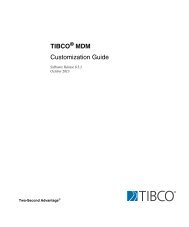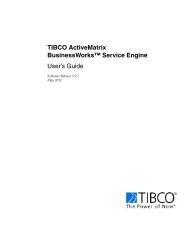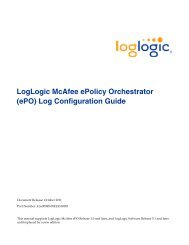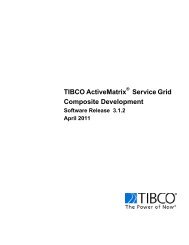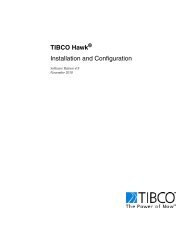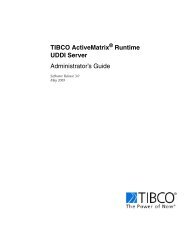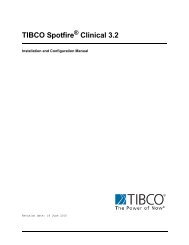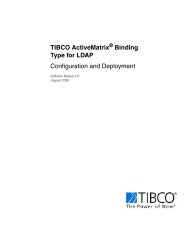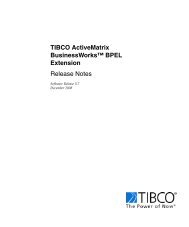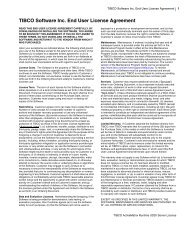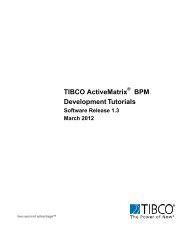TIBCO Spotfire Server 3.2.2 - TIBCO Product Documentation
TIBCO Spotfire Server 3.2.2 - TIBCO Product Documentation
TIBCO Spotfire Server 3.2.2 - TIBCO Product Documentation
Create successful ePaper yourself
Turn your PDF publications into a flip-book with our unique Google optimized e-Paper software.
Authentication and User Directory<br />
can choose to configure all settings on each server, or to configure the settings that<br />
apply to the entire cluster in the Configuration Console and only the settings unique to<br />
each server on the actual server. Which of these options you select can depend on<br />
many factors in your <strong>Spotfire</strong> system and Windows Domain.<br />
The settings that need to be unique for each server are how the <strong>Spotfire</strong> <strong>Server</strong><br />
authenticates with the Windows Domain. This can be achieved either by creating and<br />
specifying different Service accounts, or by using the Service accounts for all servers,<br />
but using different NETBIOS names for this account. For most situations, it is<br />
recommended to use different Service accounts.<br />
If you choose to configure some settings in the Configuration Console and some on<br />
each server, simply leave the settings that you will set on each <strong>Spotfire</strong> <strong>Server</strong> blank in<br />
the Configuration Console.<br />
On the same tab where you enabled NTLM, there are a number of settings that you<br />
need to specify.<br />
DNS domain<br />
Resolve DNS domain<br />
Service account name<br />
Service password<br />
AD site<br />
Specifies the DNS domain name of your Windows<br />
Domain.<br />
Example: yourorganization.com.<br />
Note: If for some reason you cannot specify a domain<br />
here, you can specify a hostname of a Domain<br />
Controller instead. If you do this, set Resolve DNS<br />
domain to No.<br />
Specifies whether the name specified in DNS domain<br />
should be considered a domain name or a hostname.<br />
Specifies the username of the prepared computer<br />
service account set up to perform NTLM<br />
authentication.<br />
Example: spotfiresrv$@yourorganization.com<br />
Note: The local part of the account name (spotfiresrv)<br />
in the example above, must not exceed 15 characters.<br />
Also note the dollar-sign ($) after the local part of the<br />
name.<br />
Specifies the password of the prepared computer<br />
service account set up to perform NTLM<br />
authentication. This password will be stored encrypted<br />
in the <strong>Spotfire</strong> Database.<br />
Specifies the Active Directory Site where the <strong>Spotfire</strong><br />
system is located. This setting is optional, but can<br />
potentially increase performance.<br />
Example: organization-got<br />
<strong>TIBCO</strong> <strong>Spotfire</strong>® <strong>Server</strong> <strong>3.2.2</strong> 77 (144)



